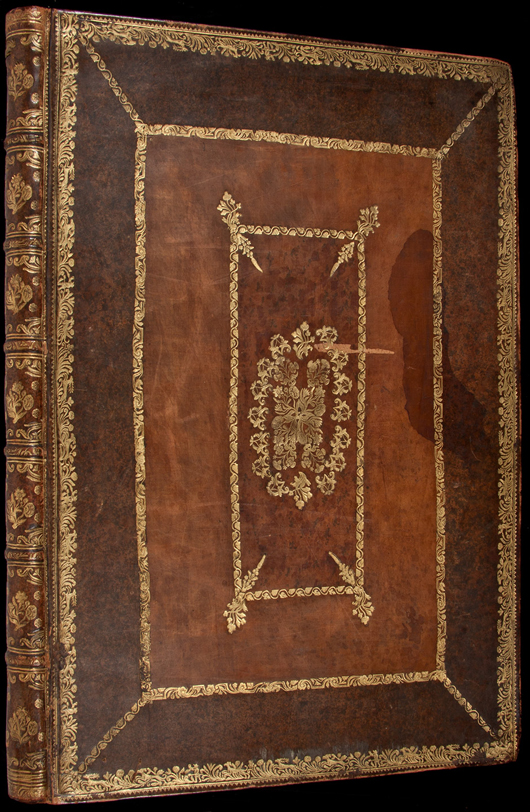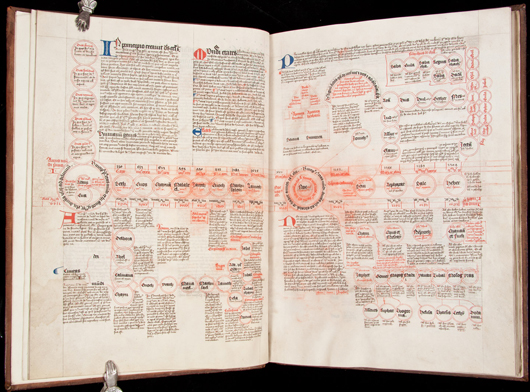
Tooled gold leaf adorns many pages of the ‘Fasciculus Temporum’ manuscript. PBA Galleries image.
SAN FRANCISCO – A rare 15th century manuscript of Werner Rolewinck’s world history, Fasciculus temporum, sold for $102,000 at PBA Galleries’ June 21 auction of rare books and manuscripts, within the range of the $100,000-$150,000 estimate. The strong price demonstrates the vigor of the antiquarian market, as rare and important material continues to climb in value.
Rolewinck’s Fasciculus temporum was a significant work in its day, a history of the world with dual parallel timelines dating both from creation and the birth of Christ. The manuscript version that sold at PBA Galleries dates from around 1471, preceding the first printing of 1474 by Arnold ther Hoernen in Cologne. There are only 13 known manuscript examples extant, and six of those were produced after the printed version came out—and the copy at PBA Galleries was the only one known to be in private hands.
Rolewinck’s history was important, not the least for its being immensely popular it its day. It went through 30 editions before 1500 and was the best-selling 15th century book by a contemporary author. Indeed, the Fasciculus was apparently the second publication of any living author, seeming to be predated only by Robertus Valturius’ De re militari (1472).
Besides being rare and important, the Fasciculus manuscript has another characteristic that lends to its great desirability and value, that of beauty. It is a striking example of the craft of the medieval scribe, calligrapher and illuminator. The manuscript comprises 30 vellum leaves, in Latin, handwritten in brown and red ink, with numerous roundels in red. There are three miniature paintings in colors (of Joseph, Mary and the baby Jesus in the manger; Christ nailed to the cross; and a resurrected Christ, a nimbus of tooled gold leaf surrounding his head, holding a gold leaf orb that is also delicately tooled), and a large, elaborate initial in red and blue leading off the text, with several smaller initials in red or blue. Of further note is the large size of the manuscript, done in “Grand Format,” dwarfing the printed versions. This allows fuller utilization of the elaborate roundel format, with an elegance and beauty not available in the printed version. This grand format is a characteristic of the prepublication manuscripts only. Post-1474 manuscripts typically followed the smaller format of the printed book. The printed examples did have a series of small woodcut illustrations, markedly different from the three beautifully executed miniature paintings in this manuscript. The manuscript is elegantly bound in 17th century paneled calf with gilt tooling.
For the full catalog description of the Fasciculus temporum, go to www.pbagalleries.com and click the catalogs link on the toolbar.
Click here to view the fully illustrated catalog for this sale, complete with prices realized.
ADDITIONAL LOTS OF NOTE
The ‘Fasciculus Temporum’ manuscript is bound in 17th century paneled calf with gilt tooling. PBA Galleries image. Pages of the ‘Fasciculus Temporum’ manuscript measure 17 1/4 by 11 1/2 inches. PBA Galleries image.


